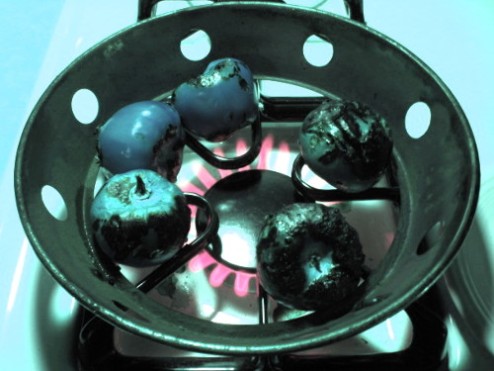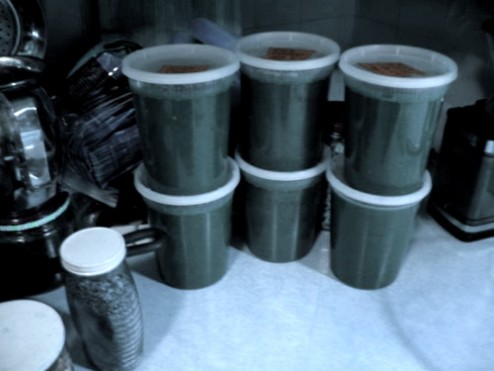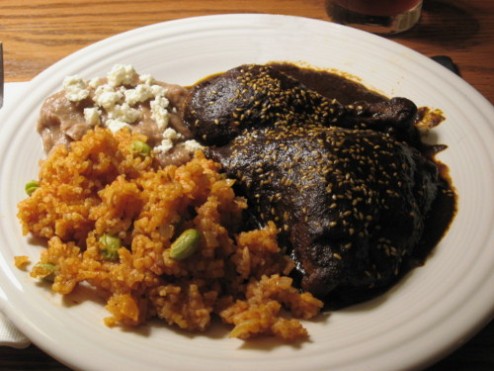Mole Poblano
A few months ago I held a quiz, and the grand winner of that rather tricky quiz was a very dear blogging-friend of mine who somehow managed to choose her own prize! Luckily, the poor thing seldom has visitors to her blog and, thus, has no need to run and hide in shame. 😀 Nevertheless, fair is fair and the agreed-upon prize (did I say that?) was that I would cook and post any dish of her choosing. Sounds easy eh? Not! She chose a dish that I have made but once before, and in that a most time-consuming, complicated, and basically the greatest pain-in-the-ass recipe I’ve ever cooked in my life… mole poblano… There might be people out there who could attest, in queso blanco-like modesty, that, in the end, it is worth all of the effort.
The word mole is used in Mexico to denote a complicated sauce, and is decended from the Aztec word molli which means a sauce or mixture containing chiles. Mole poblano is the most well-known of them, and is the basis of the holiday dish, mole poblano de guajolote (Pueblan mole of turkey), but it is just as often, if not moreso, used to cook chicken (mole poblano de pollo), and sometimes pork or other meats. There is a fanciful legend in Mexico about the dish’s origin, and it goes something like this:
“…in the 16th century the nuns of the convent of Santa Rosa in the city of Puebla heard that the archbishop was coming to visit them. They went into a panic because the convent had nothing suitable to offer such a distinguished visitor, but after a while they rallied, prayed and- with heavenly guidance- began to grind and chop everything edible that they had in the kitchen. Into the mix went (among other things) many kinds of chile, almonds, tomatoes, onions, garlic, bread, tortillas, bananas, sesame seeds, sugar, raisins, lard, toasted avocado leaves and innumerable herbs and spices. All were finely ground and cooked for hours. The final touch was a small quantity of chocolate, which gave the mole its subtle flavour. While the sauce was simmering in a great pot the nuns killed their one and only turkey (which was intended for the local bishop), cut it up and cooked the meat. When the archbishop arrived, they served the turkey with the miraculous mole poured over it. The noble guest was, of course, delighted. The angels who guided the hands of the nuns had created the most delicious dish that he had ever tasted.” *
In truth, mole poblano is a very Aztec dish, with a few Spanish ingredients whirled into the mix. While quite likely that the nuns in the convents of post-conquest Mexico did indeed improve upon the dish, it almost certainly was in existence long before that time (there are, besides the Pueblan-style, many other types of mole– guaca-mole, for example, being quite familiar to many- all considered classics of Mexico’s various cuisines and definitely worth furthur investigation). I have tasted mole poblano many times, in various Mexican restaurants, as it has long been a favorite: I fell in love with its intoxicating, nearly-indescribable, subdued chocolate-laden bouquet from the first bite! As other afficionados will attest, nothing else in the world is quite like it…
Here is my quite-recent rendition of mole poblano, which I have based upon several recipes that I had gathered, the most-admired from The Taste of Mexico by Patricia Quintana. I ended up with 27 ingredients for the sauce alone (33 after I cooked chicken in it), but the resulting tasks are quite easily accomplished in parts. I’d recommend taking three days. I divided the ingredients into categories with similar treatments, with my own steps explained afterward. You may choose a different order entirely, of course. This recipe makes enough sauce for 20 lbs. of turkey or chicken. Obviously this is enough for a banquet, but since it is almost as easy(?!) to make a large amount (and freeze what is unused for later meals) as it is a small one, I chose to go ahead with it, but you can divide it for smaller portions if you wish. I chose to thin the sauce as it simmers with just water, leaving the sauce neutral to re-thin and simmer again later with various meat stocks, or to keep as is for vegetarian meals. Lard is the traditional fat used for frying the various ingredients (and it does lend a unique flavour to foods cooked with it), but I chose to use peanut oil, again for neutrality and also to reduce the saturated fat content. Use as much as you feel necessary, keeping in mind that 2-3 cups is traditional for this quantity. I managed to use around 1 cup.
Mole Poblano
Chiles:
30 dried mulato chiles
16 dried ancho chiles
6 dried pasilla or pasilla negra chiles
2 dried chipotle chiles
1)Remove the seeds and membranes of the mulato, ancho and pasilla chiles; tear into small pieces. Take these pieces and roast lightly- in batches of three large handfuls or so- until they blister and turn a shade darker- in a pan set over med-low heat, pressing with a spatula, turning, pressing…about 10 turns. I will warn you that the chile-fumes can be quite irritating to the mucous-membrane; open windows if possible.
2)Transfer to a large bowl along with the chipotle chiles and pour boiling water over them to cover, plus an inch or two; set a plate or bowl atop the surface to keep the chiles immersed; soak 30 minutes.
3)Mexican chiles sometimes tend to have traces of dirt still clinging to them (especially ancho chiles), so when removing these pieces from their soaking-liquid, I grab a few at a time and swish them a bit in the water to reduce this to a minimum; transfer to the container of a food processor and puree until very smooth, decanting some of the soaking-water off the top (the dirt settles at the bottom) to add to the container to facilitate easy movement of the mixture. Pass this puree through a metal sieve using a wooden spoon (or use a food-mill/Foley) to attain a smooth sauce, free of annoying bits of chile-skin.
Nuts:
3/4 C raw almonds
1/2 C raw peanuts
1/2 C raw pepitas (pumpkin seed kernels)
1)Take 3 T of oil and fry the nuts separately, in the order given, over med-low heat until fragrant and golden; drain together on paper or in a metal sieve.
2)When cool, grind very well into as smooth a paste as possible. (I used a mortar-and-pestle for the initial grind, then pureed it furthur with later ingredients)
Dried fruit:
1 C pitted prunes
3/4 C raisins/sultanas
1)Using about 2 T of oil, fry the prunes over med-low heat for a few minutes to carmelize; remove and drain.
2)Fry the raisins in the same oil until they swell like little balloons; remove to drain with the prunes; pour boiling/hot water over them to cover and allow to soak for, well…awhile…
Fresh fruits:
1 1/2 ripe plantains
3 ripe tomatoes
10 tomatillos, husks removed
1)Peel and slice the plantain into 1/4″ slices. Fry in a tablespoon or two of oil over med-high heat until lightly browned; remove and set aside.
2)If you have a gas range, line a burner with foil to catch drips and with it set on high, fire-roast the tomatoes and tomatillos directly on the grate, using a pair of tongs to turn occasionally and char to black as much of the skin as possible on each (I used a wok-ring to contain mine). Traditionally, this is done over an open fire, so if you have one, then by all means…this can also be done in a very hot oven by placing the fruits on a parchment-paper-lined baking sheet to roast until the skin is charred. In any case, immediately remove to a covered container- the steam helps to soften the skin. When cool, rub off as much of the charred skin as possible under gently-running water; remove the stems and cores of the tomatillos; add to the bowl containing the fried plantains.
Breads:
1 stale croissant or 2 slices of bread or equivalent (a roti or parantha would be fine), broken into pieces
2 corn tortillas, broken into pieces
1)Fry these separately in the oil left over from the previous fryings until crispy-toasted. Remove to the bowl of fruit.
Spices:
3/4 C white sesame seeds
5″ of true cinnamon, broken into pieces
1 t coriander seeds
1 t anise seeds
1/2 t whole cloves
1/2 t black peppercorns
dried avocado leaves (I could find no reference for how much to use and therefore didn’t include)
1)Wipe the pan of excess oil and roast the sesame seeds, stirring constantly, over a med-low flame until a deeper golden hue is attained. Remove to a bowl to cool.
2)Roast the remaining spices together over a med-low flame, again stirring constantly, until the coriander seeds turn just a shade darker and the mixture is quite fragrant. Remove to a separate bowl to cool.
3)Grind the sesame seeds to a fine paste; grind the other spices to a fine powder.
Alliums:
2 heads(entire bulbs) of garlic
4 onions
1)Separate the cloves of garlic but leave the peels intact. Set them in one layer in the pan over med heat and roast until black and charred in spots, turning every few minutes. Remove and cool, then peel carefully.
2)Cut the onions in half, and then into 1/8″ slices; fry in 4-5 T oil over high flame, stirring constantly, until they begin to brown. Reduce heat and continue browning, never letting the utensil rest, until dark brown (not black) and crispy. Remove to cool.
The end is near with that final touch:
1)Place the chile-puree in a large stock-kettle.
2)Puree the nut-paste with the dried fruits and their soaking-liquid until smooth, adding more water if necessary; add to the kettle.
3)Puree the fresh fruits and the breads, adding water if necessary, until smooth; add to the kettle.
4)Add the ground spices to the kettle.
5)Puree the garlic and onions with a bit of water until smooth; add to the kettle.
6)Mix together well, adding some water if too thick to stir easily; bring gently to a boil over med-low heat, stirring occasionally, and then add:
3/4 C piloncillo, grated (Mexican raw sugar), or other sugar
4 oz. unsweetened chocolate, grated
salt to taste
Continue to boil gently, stirring occasionally, and season sparingly with:
1/4- 1/2 t Mexican oregano (not the same as European/Greek oregano)
Rub the dried herb between your fingers to crush before adding; it has a flavour not unlike ajwain, but with a strange, round, vanilla-like undertone which complements the chocolate note well. Be careful not to overdo it though…keep it subtle.
At this point, after perhaps 20-30 minutes, I decided to turn off the heat, let it cool and divided it into 8 portions (1 quart each). I froze 6 of them with labels stating the following: enough for 2.5 lbs. of meat, thin with stock, simmer 3-4 hours.
The remaining two portions- enough for 5 lbs. of meat- went thus:
5 lbs. (bone-in) chicken
1/2 onion, roughly chopped
5 cloves of garlic, sliced
1 small carrot
1/4 of a celery stalk
2 bay leaves
3 black peppercorns
salt
1)Place all ingredients in a stock-pot and bring to a boil; lower heat and simmer 30 minutes; allow chicken to cool in the stock, then remove.
2)Strain this stock, combine this with enough mole poblano for 5 lbs.(see note below), bring to boil, and lower heat to maintain a gentle boil for 3-4 hours and reduce until thick, stirring frequently, moreso as it thickens.
3)If you wish, remove the skin from the chicken pieces, and, again if you wish, shallow-fry to brown in hot oil (it is likely traditional to brown leaving the skin intact). Place the chicken pieces in the mole and simmer for 30 minutes, covered.
4)Remove to a serving platter and sprinkle with:
A few tablespoons of sesame seeds, toasted as above
Serve with hot tortillas, arroz rojo(red rice pilaf), frijoles(refried beans), salsa picante(hot sauce), and, as I have often been served, pico de gallo (a fresh relish made of tomatoes, onions, green chiles, cilantro, lime juice and salt..maybe some roasted cumin- I forget).
Note (as if there weren’t enough): The mole is usually thinned with a richer stock (ie: return the bones and scraps to the stock and simmer at least 3 hours longer) when cooking meats; I was tired, but I actually liked the diminished chicken taste to better enjoy the other flavours.
“I’m not really interested in how it’s made; just let me eat it, eh?” -Danny
Anita– I seriously loved working on this recipe- great fun with a dish people seldom attempt at home anymore- even amongst Mexicans. Congratulations! and enjoy…
Special bonus! The halved recipe (for 10 lbs. of turkey or chicken):
15 mulato chiles, 8 ancho chiles, 3 pasilla negra chiles, 1 chipotle chile, 3/8 C almonds (1/4 C + 2 T), 1/4 C peanuts, 1/4 C pepitas, 1/2 C prunes, 3/8 C raisins, 3/4 of a ripe plantain, 1 1/2 ripe tomatos, 5 tomatillos, 1/2 of a croissant (or 1 slice of bread or half of a roti, etc), 3/8 C sesame seeds, 2 1/2″ of cinnamon, 1/2 t coriander seeds, 1/2 t anise seeds, 1/4 t whole cloves, 1/4 t black peppercorns, 1 head of garlic, 2 onions, 3/8 C piloncillo, 2 oz. unsweetened chocolate, salt, a pinch of Mexican oregano, oil or fat, and water as required…note that the quantity of chicken used above is for a quartered amount (5 lbs.)- use half of this quantity of sauce and freeze the other.
This is my entry for Jihva for Ingredients- chocolate, hosted this month by Deepz of Letz Cook. JFI is a monthly tradition, created by Indira of Mahanandi.
*Excerpt taken from Latin American Cooking, Jonathon Norton, co. 1968.







